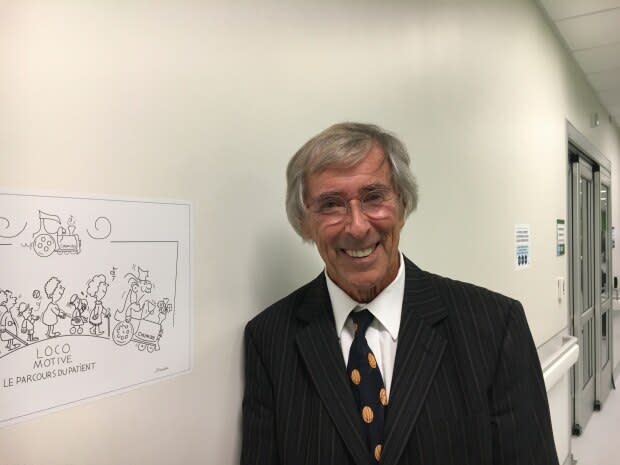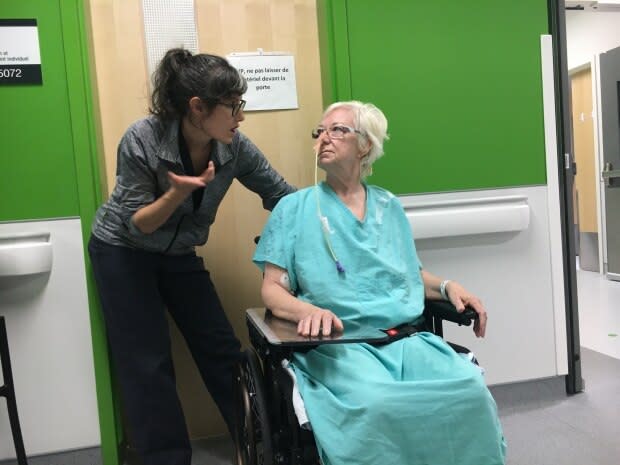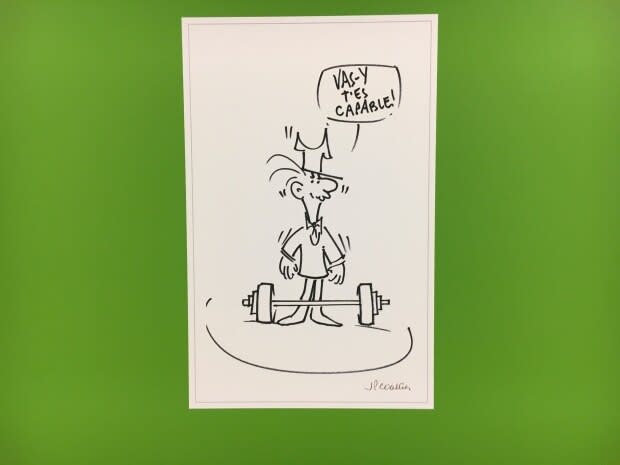How a stroke survivor's cartoon characters are helping others rehabilitate
Diane Courchesne sits in her wheelchair, determined. Gripping the chair's sides, she pushes herself up slowly, using images on the wall as a reference point. With a physiotherapist by her side, she is training herself to move again.
Courchesne is one of dozens of patients currently being treated for a stroke at the Centre hospitalier de l'Université de Montréal (CHUM). Courchesne has been non-verbal since her stroke, but she shakes her head whenever her physiotherapist asks if she needs a break.
Pushing herself along in her wheelchair, she moves along the corridor, trying one exercise after another. Courchesne is one of the first to use the CHUM's new Locomotive circuit, which aims to help patients rehabilitate both physically and cognitively.

Since the CHUM's neurological unit moved to the new superhospital, patients have been placed in private rooms, meaning they had less opportunity for social interaction.
"We wanted to give them an opportunity to go out, to be active, to have interactions and to have cognitive stimulation," said Dr. Céline Odier, a vascular neurologist and one of the people at the helm of the project.
The new circuit consists of three stations: one where patients can read information on stroke prevention and rehabilitation; a language station, and an exercise space.
It is open at all hours of the day and night, allowing patients to explore the exercises by themselves and with their family members, when their physiotherapists aren't around. Doctors hope it will allow patients to become more independent before they head to rehabilitation centres.
'I don't want to remember too much'

Comic illustrations of a stroke-surviving character, Jules, line the walls of the corridor. Their creator is 82-year-old Jean-Pierre Coallier, who survived a stroke himself.
"Fortunately, I'm all right now. My memory is failing once in a while, but that's all right for me. I don't want to remember too much," Coallier jokes.
Coallier had a stroke about 10 years ago that impaired his ability to speak and understand languages. A long-time radio and television broadcaster, he had to take time off work and train himself to speak again.
In the 1960s and 70s, Coallier was a cartoonist for Montréal-Matin, a daily newspaper at the time. He decided to repurpose the character he'd created for those comics, Jules, for the illustrations on the hospital walls.
"I switched out his broom for a cane, and I gave him the brain of Youppi," said Coallier.
"I wanted to give a bit of hope to people who are afflicted with a stroke. A bit of hope, and some smiles."
The images are placed randomly around the unit to act as a search-and-find game for patients. When they come across an illustration, they are encouraged to point it out to their doctors and describe what they see. Over time, this will help them improve their memory and language skills again, Odier explained.
The hospital has been working on translating the material it's created for the wing, in the hope that other hospitals and medical centres in the country can adapt it for their own use.
'My life would be different'

Serge Gareau was in his car with his two teenage daughters when he suddenly lost all sensation in the right side of his body. Twelve years after his stroke, he now works as a patient partner at the CHUM, helping patients and their families cope with their new diagnosis.
"They tell me their fears, their worries. It could be about their job, it could be about returning home," said Gareau.
Gareau said he is amazed by the Locomotive corridor whenever he walks through it. He finds himself looking at the illustrations to keep his own morale up and to keep his memory strong.
"If I would of had this 12 years ago, my life would be different today," said Gareau.

